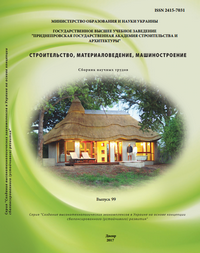Main parameters and their influence on the energy efficiency of residential buildings of various numbers of floors
Keywords:
energy efficiency, heat losses, number of floors, density coefficient.Abstract
Annotation. Formulation of the problem. The development and improvement of the energy efficiency concept of residential and civil buildings has become extremely relevant over the last several years. The reason for this is a constant increase in tariffs for utilities, as well as energy and has become one of the main directions for the construction industry development. A lot of attention with the new construction, repair or reconstruction of an existing building is paid to the accounting and saving of input energy resources. In European countries the development of standards for the level of energy consumption reducing has begun as early as the end of 1970 through enclosing structures and vented air. According to the decisions of the European Parliament to the December 31, 2020, all newly erected buildings in the EU should correspond to the level of energy consumption minimum or zero, in addition the most part of the houses energy consumption should be consumed from a renewable energy source. The heat is usually lost through the enclosing structures, resulting in inefficient thermal insulation and irrational use of already heated ventilated air. About 40% of all heat energy is spent currently on the existing housing stock servicing. Purpose of the article. With the use of model representations, the calculation of heat losses of residential buildings of various numbers of floors has been made with the variation of design parameters: number of floors, floor height, column spacing, glazing area, with the norms permitted by the standards.References
Mіnregіonbud Ukraїni. Konstrukcії budinkіv ta sporud. Teplova іzolyacіya budіvel': DBNV.2.6-31:2006. zі Zmіnoyu №1 vіd 1 lipnya 2013 roku [Heat insulation of buildings: DBNV.2.6-31: 2006. With the change №1 from July 1, 2013]. Kyiv, 2006, 70 p. Available at: http://www.dbn.at.ua. (in Ukrainian).
Mіnregіonbud Ukraїni. Proektuvannya. Nastanova z rozroblennya ta skladannya energetichnogo pasporta budinkіv pri novomu budіvnictvі ta rekonstrukcії: DSTU-N B A.2.2-5:2007 [Guidelines for the development and preparation of energy passports of buildings in new construction and renovation, DSTU-H B A.2.2-5: 2007]. Kyiv, 2008, 44 p. Available at: http://www.dbn.at.ua. (in Ukrainian).
Koval E. A. Energoeffektivnost arhitekturno-konstruktivnyh sistem maloetazhnyh zhilyh zdanij: Dis. kand. tehn. nauk: 05.23.01.[ Energy efficiency of architecturally-constructive systems of low-rise residential buildings: Dis. kand. Cand. Tech. Sciences: 05.23.01.]. Dnepropetrovsk: 2012, 152 p. (in Russian).
Koval O. O., Savickij M. V., Yurchenko Є. L., Kovtun-Gorbachova T. A. and Lucenko Yu. O. Energoefektivnіst malopoverhovih budіvel v zalezhnostі vіd їh ob'єmno-planuvalnih, arhіtekturnih ta konstruktivnih osoblivostej [Energy efficiency low-rise buildings depending on their space-planning, architectural and design features]. Stroitelstvo, materialovedenie, mashinostroenie – [Сonstruction, materials science, mechanical engineering]. PDABA. Dnipropetrovsk, 2011, no. 58, pp. 395–400. (in Ukrainian).
Necheporuk A. A. Normirovanie utepleniya zdanij v Ukraine. Dostizheniya i problemy [Normalization of building insulation in Ukraine. Achievements and challenges]. Zhilischnoe stroitelstvo [Housing construction]. 2007, no. 12, pp. 13– 15. (in Russian).
Karapuzov Є. S. and Soha V. G. Uteplennya fasadіv [Insulation of facades]. Vischa osvіta [Higher Education]. Kyiv, 2007, 318 p. (in Ukrainian).
Downloads
Published
Issue
Section
License
Редакція Видання категорично засуджує прояви плагіату в статтях та вживає всіх можливих заходів для його недопущення. Плагіат розглядається як форма порушення авторських прав і наукової етики.
При виявлені у статті більш ніж 25% запозиченого тексту без відповідних посилань та використання лапок, стаття кваліфікується як така, що містить плагіат. У цьому випадку стаття більше не розглядається редакцією, а автор отримує перше попередження.
Автори, в статтях яких повторно виявлено плагіат, не зможуть публікуватися в усіх журналах Видавництва ДВНЗ «Придніпровська державна академія будівництва та архітектури».
Автори, які публікуються у цьому журналі, погоджуються з наступними умовами:
- Автори залишають за собою право на авторство своєї роботи та передають журналу право першої публікації цієї роботи на умовах ліцензії Creative Commons Attribution License, котра дозволяє іншим особам вільно розповсюджувати опубліковану роботу з обов'язковим посиланням на авторів оригінальної роботи та першу публікацію роботи у цьому журналі.
- Автори мають право укладати самостійні додаткові угоди щодо неексклюзивного розповсюдження роботи у тому вигляді, в якому вона була опублікована цим журналом (наприклад, розміщувати роботу в електронному сховищі установи або публікувати у складі монографії), за умови збереження посилання на першу публікацію роботи у цьому журналі.
- Політика журналу дозволяє і заохочує розміщення авторами в мережі Інтернет (наприклад, у сховищах установ або на особистих веб-сайтах) рукопису роботи, як до подання цього рукопису до редакції, так і під час його редакційного опрацювання, оскільки це сприяє виникненню продуктивної наукової дискусії та позитивно позначається на оперативності та динаміці цитування опублікованої роботи (див. The Effect of Open Access).

